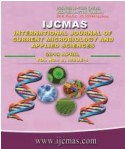


 National Academy of Agricultural Sciences (NAAS)
National Academy of Agricultural Sciences (NAAS)

|
PRINT ISSN : 2319-7692
Online ISSN : 2319-7706 Issues : 12 per year Publisher : Excellent Publishers Email : editorijcmas@gmail.com / submit@ijcmas.com Editor-in-chief: Dr.M.Prakash Index Copernicus ICV 2018: 95.39 NAAS RATING 2020: 5.38 |
The present study was undertaken to evaluate the physicochemical and microbiological analysis of water of the Bidar district, Karnataka. Tap water samples (n=82) were collected from 05 talukas of Bidar district. The samples were subjected to physical analysis. The parameters included were hardness, pH, total dissolved solids, turbidity, color, and taste. Chemical parameters included were nitrates, nitrites, chloride, ammonia, fluoride, lead, arsenic, iron, sulfates and copper. The bacteriological examination of water sample includes the most probable number of presumptive coliform as suggested by WHO (1971) & BIS (1991). The physical tests were performed by subjecting the water samples using physical parameter testing equipment and chemicals. Chemical parameters were tested by using prescribed chemicals and following standard protocols. The bacteriological quality of the water was tested by following standard protocol of most probable number procedure. The pH of the 72 samples shown range from 6.5 to 8.5 which is the acceptable limit by WHO but the remaining 10 samples, from that 9 sample shown pH range 8.9-9.3 and one sample has shown PH 6.1. The turbidity of the water sample ranged from 0.5 to 2.85 Nephelometric Turbidity Unit (NTU) which is well below the maximum permissible limits i.e. 5 NTU (WHO). The total hardness of the 65 samples shown ranges from 65-145 ppm which is the acceptable range (moderately hard water) for drinking water whereas 17 samples shown ranges from 150-250 ppm indicating hard water. The chemical evaluation of the sample shown negative to all the parameters mentioned above except chloride which was positive in 07 samples. In the bacteriological analysis, the most probable number (MPN) count ranged from 03 to 1100 for 13 samples and rest 69 samples shown a negative result for coliforms. From 08 MPN positive samples, E.coli was isolated by the standard microbiological procedure. To conclude water samples under the area of investigation shown a range of quality ranging from unfit for consumption to fit for consumption. There is a need to spread awareness among the communities regarding the quality of the water.
 |
 |
 |
 |
 |